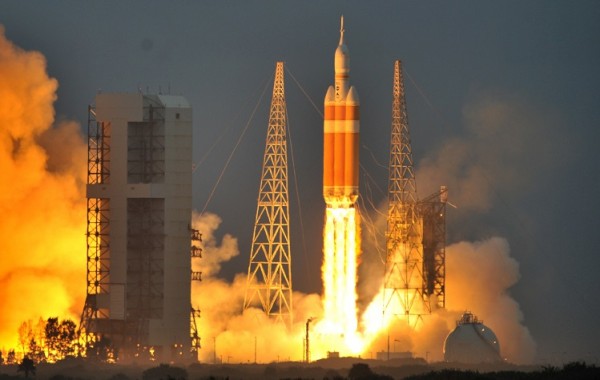First Launch of America's Mars Spacecraft a Success
| Ana Verayo | | Dec 05, 2014 10:25 PM EST |
(Photo : Reuters) The Delta IV heavy rocket with the Orion spacecraft lifts off from the Cape Canaveral Air Force Station in Cape Canaveral, Florida December 5, 2014.
NASA's Orion capsule successfully splashed down in the Pacific Ocean off California after an equally successful liftoff from Florida Friday morning. The Orion spacecraft is slated to become the first U.S. spacecraft to travel into deep space and eventually to Mars.
Orion capsule program manager Mark Geyer was pleased by the success, saying it's hard to have a better day than today after landing.
Like Us on Facebook
The initial launch date Thursday was moved to Friday due to gusty winds and some last minute technical difficulties as the launch window expired.
The Orion Exploration Test Flight-1 involved the Orion capsule mounted on a Delta IV Heavy rocket, the biggest rocket ever made by NASA. The rocket blasted-off from the seaside spaceport of Cape Canaveral Air Force Station in Florida.
After reaching 3,604 miles into space, Orion plummeted back into the planet's atmosphere at the extreme speed of 32,000 kilometers per hour.
Orion survived its re-entry into the Earth's atmosphere as it heated up to a scorching 4,000 degrees Fahrenheit, comparable to the heat of molten lava. It also withstood gravitational forces eight times stronger than Earth's.
As it descended, Orion deployed 11 parachutes, including three giant main chutes that slowed down the capsule's velocity to 20 miles per hour for a splashdown some 630 miles from San Diego, California on Friday 11:29 a.m. EST.
Data from Orion's first space flight will now be consolidated by the mission team. Critical data to be studied include how Orion handled radiation surges as it passed through the Earth's protective magnetic field.
The Orion mission cost about US $375 million. Its primary goal was to test Orion's 16.5 diameter heat shield, parachute systems and avionics that will be pivotal to the development and design of the capsule when astronauts travel to Mars in the 2030s.
TagsMeet America's New Spacecraft: NASA Orion Launch a Success, NASA, orion launch, orion photos, mars exploration, orion launch nasa success test flight
©2015 Chinatopix All rights reserved. Do not reproduce without permission
EDITOR'S PICKS
-

Did the Trump administration just announce plans for a trade war with ‘hostile’ China and Russia?
-

US Senate passes Taiwan travel bill slammed by China
-

As Yan Sihong’s family grieves, here are other Chinese students who went missing abroad. Some have never been found
-

Beijing blasts Western critics who ‘smear China’ with the term sharp power
-

China Envoy Seeks to Defuse Tensions With U.S. as a Trade War Brews
-

Singapore's Deputy PM Provides Bitcoin Vote of Confidence Amid China's Blanket Bans
-

China warns investors over risks in overseas virtual currency trading
-

Chinese government most trustworthy: survey
-

Kashima Antlers On Course For Back-To-Back Titles
MOST POPULAR
LATEST NEWS
Zhou Yongkang: China's Former Security Chief Sentenced to Life in Prison

China's former Chief of the Ministry of Public Security, Zhou Yongkang, has been given a life sentence after he was found guilty of abusing his office, bribery and deliberately ... Full Article
TRENDING STORY

China Pork Prices Expected to Stabilize As The Supplies Recover

Elephone P9000 Smartphone is now on Sale on Amazon India

There's a Big Chance Cliffhangers Won't Still Be Resolved When Grey's Anatomy Season 13 Returns

Supreme Court Ruled on Samsung vs Apple Dispute for Patent Infringement

Microsoft Surface Pro 5 Rumors and Release Date: What is the Latest?










